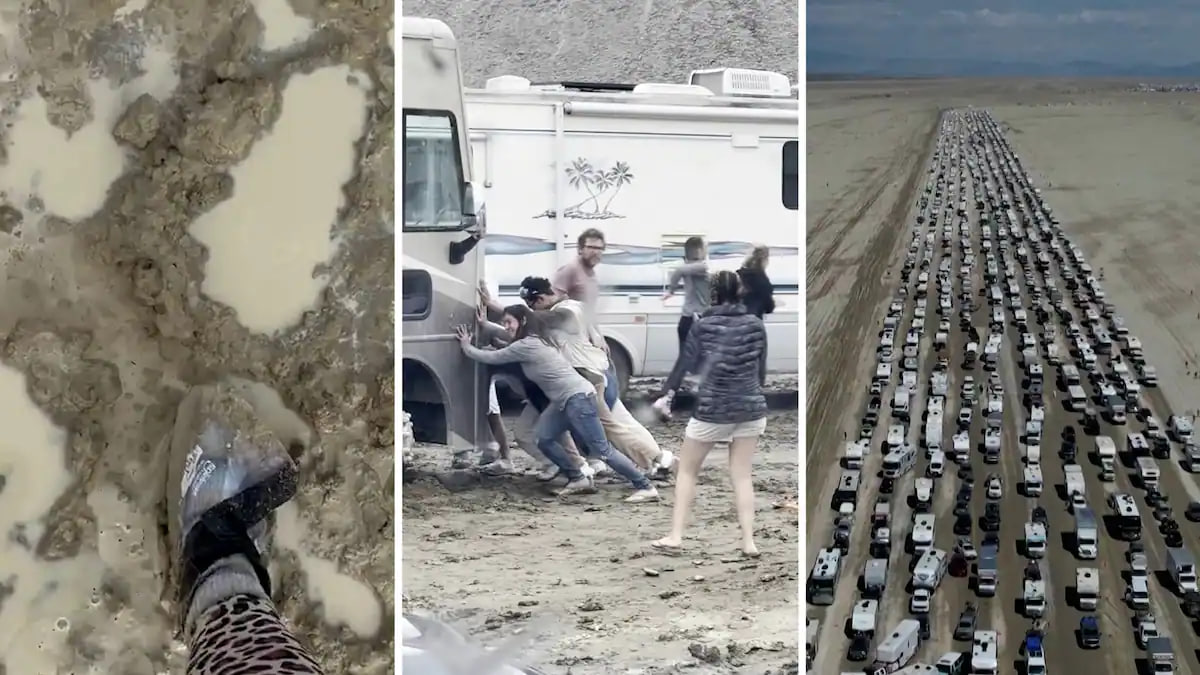Burning Man attendees had to adapt in real time as rain turned their desert oasis into a muddy pit
Burning Man is supposed to arrive and disappear like the desert breeze.
Near the end of every summer, attendees of the multiday mega-festival venture to the Nevada wilderness. Their motto: “Leave no trace.”
This year, thousands got stuck in the mud instead after about a half an inch of rain hit what is normally the driest state in the nation. Instead of leaving no trace, many self-described “burners” abandoned bicycles and vehicles on the drenched, muddy Black Rock Desert.
Once an underground carnival for free spirits, Burning Man today is famous as a party spot for Hollywood stars, Silicon Valley tech bros and other jet-set elites. The latest event offers a glimpse at how extreme weather can — and more frequently will — dramatically transform the environment in a moment’s notice.
“It’s a teachable moment, as far as climate disasters and extreme weather” go, said Anya Kamenetz, a Burning Man attendee forced to flee the festival. “This is very much just a trial run under really, really easy conditions for what a lot of people go through.”
No single storm can be attributed to climate change. But flooding in Nevada is expected to become more frequent as storms intensify and snow shifts to rain due to higher temperatures, according to state officials.
On Aug. 27, as the festival was getting started, climate activists blockaded a road into Burning Man in protest of its environmental footprint.
This year’s event is only expected to fuel critics who have long charged the festival for leaving trash in surrounding communities and not living up to its eco-conscious goals as crowds rush away from the encampment. As festivalgoers made the long trek to the exits, they left more behind than usual, including cars, Pershing County Sheriff Jerry Allen said.
“This behavior definitely does not fall within the 10 principles of Burning Man,” he said. The neglect, he added, is “a societal issue” and not necessarily the fault of the Burning Man Project, the group behind the festival.
Burning Man gets rained out
At first, a sprinkling of rain helped settle some of the dust swirling through the encampment. But by Friday evening, the rain didn’t stop — and it didn’t take much precipitation to turn the playa into a muddy mess.
“By the time we went to bed that night, it was really clear that this is going to be something that would shut down the city,” said Kamenetz, who writes a Substack newsletter about climate change.
By Saturday morning, the burners were trapped. Those who remained held a camp meeting, Kamenetz said. No more showers, no more dishwashing. No more portable toilet use except for solid waste.
Unsure of when attendees would be able to leave, organizers urged those who remained to conserve food, water and fuel. The gates and airport in and out of what was supposed to be a desert oasis were closed.
So, burners sheltered in place. Festivalgoers covered their tents in tarps to keep the rain out. The mud was so thick and sticky that many abandoned their hiking boots, trekking through the encampment barefoot or slipping plastic bags over their socks.
To dig mud out of a portable toilet, Kamenetz unbolted a gold-colored decorative shovel attached to a zebra-striped, safari-themed vehicle brought to Burning Man as an “art car.”
“It was gold,” she said of the shovel. “It’s not gold anymore.”
Revelers tried to make the best out of a bad situation. During the day, the group sculpted a statue of an elephant out of mud. At night, they played music. As a sign, perhaps, that things would be okay, a rainbow arched across the playa Saturday.
“People really didn’t miss a beat,” Kamenetz said.
‘Better prepared than the average Joe Schmo’
This year’s Burning Man brought some of the most extreme weather Christine Lee had seen in the eight years she’s attended the festival.
But many burners, particularly veterans of the festival, are resourceful and well-prepared for the week-plus of off-the-grid survival, said the 39-year-old circus performer. Lee traveled with friends in a built-out conversion van, so they were equipped with heat, air conditioning and power — as well as stacks upon stacks of foil-wrapped packs of tuna.
“I did have enough tuna for an extra week,” Lee said. While there were moments of panic over the sight of overflowing toilets and calls to reserve food and water, people coming to Burning Man follow the principles of self-reliance and community, she said.
“They’re going to be prepared better than the average Joe Schmo,” Lee added.
The social contract Burning Man is known for largely held up, though Lee noticed human waste outside one trailer, and more forks and litter — sights she hadn’t seen in past year. Lee chalked it up to a small percent of attendees behaving selfishly.
The broader community stepped up to clean the grounds and shelter, and to feed burners who were struggling as resources dwindled, she said. Burning Man is famously “commerce-free” — or at least strives to be — which means everything including meals and bicycle repair is barter and community-based.
“It totally worked — there’s nowhere else I’d rather be in the middle of a zombie apocalypse,” Lee said. “I’d see people walking around with trash bags, offering water, handing out food. You see someone clearly struggling because they look hungry and doesn’t have a poncho and you help them.”
The rain arrived as Reno, the largest nearby city, is in the middle of its second-wettest year on record, according to Scott McGuire, a meteorologist with the National Weather Service.
The area has entered a “boom-or-bust” mode when it comes to rain, oscillating between wet and drought years. “We swing on this pendulum,” McGuire said.
Rainstorms like the one over Labor Day weekend are unusual but not unprecedented for the region, he added.
The Southwest United States has seen more rain than normal this year, both because of an active monsoon as well as the passage of Tropical Storm Hilary. Around the same time downpours drenched Burning Man, torrential rain also brought flooding to Las Vegas, which has received 2.55 inches of rain during the monsoon season, the 11th-most on record.
On Friday, the Weather Service’s forecast had predicted isolated thunderstorms and scattered showers for the area over the weekend.
A muddy exodus
Burning Man Project chief executive Marian Goodell told NBC News that the group was “prepared for the whole spectrum” of weather scenarios.
“We’ve chosen a dry lake bed” for the event, she said. “The environment is always a survival environment.”
Yet by Sunday, an exodus was underway even as roads remained closed. Over Labor Day, people pushed RVs and kicked mud out from under wheels to get them to move. Others hoofed it by foot. Kamenetz walked more than three miles through mud to catch a bus.
Every year, large piles of trash are left in Reno and other spots outside the desert, said Allen, the Pershing County sheriff.
“This year is a little different in that there are numerous vehicles strewn all throughout the playa for several miles,” he added. “Some participants were unwilling to wait or use the beaten path to attempt to leave the desert and have had to abandon their vehicles and personal property wherever their vehicle came to rest.”
The Burning Man Project, Allen added, is responsible for cleaning up the trash in the desert. The project did not immediatelyrespond to a request for comment from The Washington Post.
By Tuesday morning, the departure was “going smoothly” despite the heavy volume of travelers, Pershing County Sheriff Sgt. Nathan Carmichael said. The only major incident from Burning Man that the sheriff’s office was actively investigating Monday was the death of Leon Reece, a 32-year-old attendee who was found unresponsive at the festival Friday.
At the Reno-Tahoe International Airport, operations were returning to “business as usual” after a double dose of traffic from Labor Day travelers and the influx of burners headed home, according to spokesperson Stacey Sunday.
The airport on Monday tallied around 7,000 passengers, Sunday said, citing TSA data — compared with 4,000 to 6,000 travelers on a typical day.
Among the ways airport officials typically prepare for Burning Man travelers is to have plastic bags on hand to wrap their dust-covered luggage so that baggage machines don’t get clogged. This year, the airport provided travelers with disposable booties to cover their mud-caked shoes.
“[It’s] our biggest thing because there’s construction going outside, there isn’t the curb for burners to sit on, make flight arrangements,” Sunday said. “They’re either inside or out, but it doesn’t seem to be a big deal.”
This year’s experience hasn’t deterred Lee from Burning Man, though she plans to pack more boots and ponchos in case of rough weather next year. Even the hard rain, she said, created a joyful, art-filled memory. During a brief period when the rain slowed this past weekend, people started walking the streets and creating mud art: clay Minions and Buddhas and snowmen.
But Kamenetz, a nine-time attendee, said this would be her last Burning Man, a decision she had considered even before the rain.
“Is this really how I want to be spending my leisure time?”
Source: Washington Post







